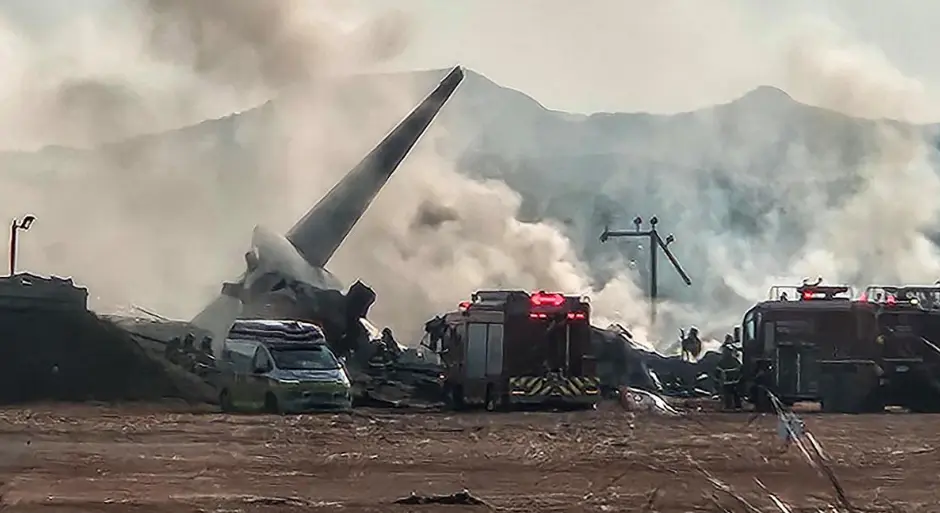On December 29, 2024, a catastrophic aviation disaster struck South Korea, marking the deadliest plane crash in the nation’s history. Jeju Air Flight 7C2216, a Boeing 737-800, was en route from Bangkok, Thailand, to Muan International Airport in South Jeolla Province. Tragically, the aircraft crashed during landing, resulting in the loss of 179 lives out of the 181 individuals on board. This incident has not only plunged the nation into mourning but has also raised critical questions about aviation safety and emergency response protocols.
What Happened and When
The ill-fated flight departed from Bangkok’s Suvarnabhumi Airport on December 28, 2024, at approximately 11:00 PM local time, carrying 175 passengers and six crew members. The journey proceeded without incident until the aircraft approached Muan International Airport around 9:00 AM local time on December 29. During the landing sequence, the plane veered off the runway and collided with a barrier, leading to a catastrophic explosion and subsequent fire. Emergency responders were dispatched immediately; however, the intensity of the blaze hindered rescue operations, resulting in a devastating loss of life.
Key Facts and Initial Reports
- Aircraft Details: The aircraft involved was a Boeing 737-800, a model renowned for its reliability and widespread use in commercial aviation.
- Casualties: Out of 181 individuals on board, 179 were confirmed deceased. The two survivors, both crew members, sustained severe injuries and were transported to a nearby medical facility for treatment.
- Passenger Demographics: The passengers included 173 South Koreans and two Thai nationals, ranging in age from 3 to 78 years old. Many were returning from holiday trips.
- Weather Conditions: Preliminary reports indicate that weather conditions were favorable at the time of the incident, suggesting that external environmental factors were unlikely contributors.
- Potential Causes: Early speculation points to a possible bird strike during the landing approach, which may have compromised the aircraft’s systems. Additionally, there are reports of a malfunction in the landing gear, though these claims require further investigation.

The Sequence of Events Leading to the Crash
- Approach to Muan International Airport: As Flight 7C2216 prepared for landing, the pilot aborted the initial approach due to reported bird activity near the runway. Air traffic controllers had issued warnings about the presence of birds in the vicinity.
- Emergency Landing Attempt: Shortly after the aborted landing, the pilot declared an emergency, citing issues with the landing gear, potentially caused by a bird strike. The crew attempted a belly landing, retracting the landing gear to minimize the risk of collapse upon touchdown.
- Crash and Explosion: Upon contact with the runway, the aircraft skidded off the tarmac and collided with a concrete barrier. The impact resulted in a massive explosion, followed by an intense fire that rapidly engulfed the fuselage.
- Rescue Operations: Emergency services responded promptly, but the ferocity of the fire impeded immediate rescue efforts. Firefighters battled the blaze for several hours before gaining control, by which time the majority of passengers had succumbed to the flames or smoke inhalation.
Immediate Response and Rescue Operations
- Emergency Dispatch: Over 1,500 emergency personnel, including firefighters, medical teams, and law enforcement, were deployed to the crash site. A special disaster zone was enforced to facilitate coordinated response efforts.
- Fire Suppression: Firefighters employed foam and water to extinguish the flames, a process that took several hours due to the intensity of the fire fueled by aviation fuel.
- Medical Assistance: The two survivors were extracted from the tail section of the aircraft and transported to a local hospital. Both individuals are reported to be in critical condition, receiving intensive medical care.
- Victim Identification: Authorities have initiated the process of identifying the deceased, utilizing fingerprint analysis and dental records. Support services, including counseling, have been made available to grieving families.
The Crash Site: Location and Investigation
Muan International Airport, situated in South Jeolla Province, serves as a regional hub for both domestic and international flights. The airport’s proximity to agricultural fields and coastal areas has been associated with a higher incidence of bird activity, posing potential risks to aircraft during critical phases of flight.
- Investigation Team: A multidisciplinary team comprising officials from South Korea’s Ministry of Land, Infrastructure, and Transport, the Aviation and Railway Accident Investigation Board, and international experts, including representatives from Boeing and the U.S. National Transportation Safety Board (NTSB), has been assembled to investigate the crash.
- Black Box Recovery: Both the Flight Data Recorder (FDR) and Cockpit Voice Recorder (CVR) have been recovered, albeit with partial damage. Decoding these devices is expected to take approximately one month and will provide critical insights into the aircraft’s performance and crew communications during the flight’s final moments.
- Site Analysis: Investigators are meticulously examining the wreckage and crash site to identify any structural failures, mechanical malfunctions, or external factors that may have contributed to the disaster.



